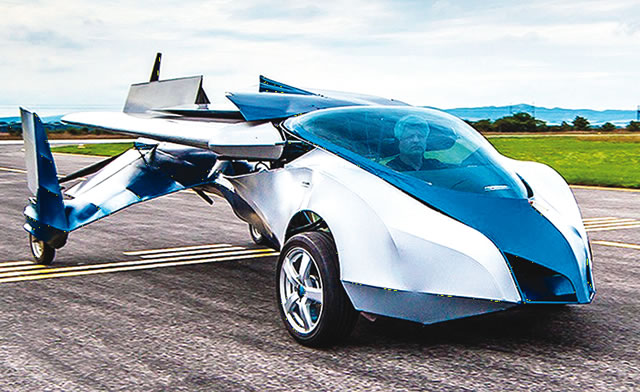Hundreds of people cheered in Mandarin as the two-seat, gull-winged plane flew up and hovered about 30 meters (100 feet) above their heads. It then slowly came back down. Some of the fans yelled at the same time, “Make us Chinese proud in Dubai!”
In the past few months, China’s Xpeng Aeroht has sent two of its planes on their first public flights. The 90-second test near Dubai’s famous Palm Jumeirah island in October was followed by another in Guangzhou, China. These were important steps for the startup, which is backed by electric vehicle maker Xpeng Inc., to overcome regulatory hurdles and get a piece of what is being called a $1 trillion market that could change the way we move.


“The flying car is getting closer to being real, and we thought it was the right time to get involved,” said Brian Gu, President of Xpeng, at an event in Dubai called GITEX. The industry has made many technical advances, like making things lighter, avoiding obstacles, and making things electric.
Some people might say that it’s way too early for that kind of nerve. Some people believe it. Aeroht was the star exhibitor at GITEX, one of Dubai’s largest trade shows every year. It was started in 2013 by 45-year-old Zhao Deli, who dropped out of high school. The leader of the United Arab Emirates, the Prime Minister, walked by the booth. People lined up at his booth, which was the busiest on the floor, to take selfies with his prototype.
The hype hides the fact that other startups have been having trouble for years. Companies like Lilium NV, Joby Aviation Inc., and Archer Aviation Inc. were worth billions of dollars when they went public, but they are now trading at or near all-time lows. In September, Larry Page’s KittyHawk stopped working.
Horizon Aircraft Inc. in Canada commissioned a study that came out this month. It says that most investors expect company closures and industry consolidation in the next few years, even though orders are starting to rise.
Zhang Junyi, a partner at the consulting firm Oliver Wyman who helped set up the investment firm Nio Capital, said that investors want to find “the Tesla of the flying car industry.” But the market might not do well for 10 to 15 years. “Putting money into the flying car business is like running a marathon.”
Aeroht is shown off by the prototype that flew in Guangzhou. Many eVTOLs, or electric take-off and landing aircraft, don’t have wheels and can’t be driven on the ground. However, the sixth-generation model from a Chinese company is a real car that can also be driven on the road. Some competitors’ designs look like small airplanes on wheels, but this one looks more like a luxury car.
In fact, the model is made to be driven on the road more than 90% of the time and flown only when there are roadblocks or traffic jams. In an interview, the company’s founder Zhao said that the car, which has four electric motors and eight propellers, could be made in large numbers by 2025.
The Price
He thinks it will cost about 1 million yuan ($140,000), which is less than Joby’s car ($1.3 million). He said that’s partly because Aeroht can use Xpeng’s huge network of suppliers all over China.
The search for eVTOLs goes back at least ten years when entrepreneurs dreamed of making the skies more accessible to everyone. (Or, more practically, hovering over what Elon Musk calls “soul-crushing” traffic.)
In the years that followed, the field got more and more crowded with people who wanted to make a dream that only existed in comics and science fiction come true. Analysts at Morgan Stanley say that the eVTOL (urban air mobility) space could be worth $1 trillion by 2040.
In the last five years, Chinese companies like Aeroht, Ehang Holdings Ltd., and TCab Tech have joined the race. They got their ideas from American names like Joby and Archer. They raised a generation of entrepreneurs and investors who tried to copy China’s success with electric cars by using many of the same advantages: a large supply chain, a large pool of skilled workers, a large domestic market, and, most importantly, support from the government.
Many people are counting on President Xi Jinping’s efforts to crowd out American technology in areas like semiconductors and climate technology to get money and political support.
“In some cases, American companies told us which sectors were promising and could make money, but their Chinese counterparts just went ahead and took over the market with lower prices,” said Warren Zhou, an investor at Decent Capital and supporter of TCab tech. He talked about drones, hoverboards, and robots that clean up. “The same is true for the industries of eVTOL and flying cars.”
Some of the biggest names in startup investing agree, including IDG Capital, Sequoia China, GGV Capital, and Hillhouse Capital, which all back Aeroht. In 2021, when the company was worth $1.5 billion, it took part in a funding round that brought in more than $500 million.
Zhao at first. In 2020, the founder of Xpeng, who had been trying for about a decade to save his company, finally succeeded. Zhao says he used a demo to convince the business owner. “Shout first or take off first?” Zhao said he asked him. “First, fly!”
Not long after that meeting in Dongguan, Guangdong Province, He and Xpeng invested in Zhao’s startup and changed its name to Xpeng Aeroht. With its main office in Guangzhou and research and development centers in Shenzhen and Shanghai, the unicorn has grown from about a dozen employees in 2020 to over 700 in July.
It joins a number of other well-funded startups, such as Shanghai-based AutoFlight, which last November got $100 million from an investor in Europe to build air taxis. Volant Aerotech was started in June 2021 and has already raised more than $14 million.
But the technology is not ready yet. A lot depends on making batteries with higher energy densities, or the amount of power per unit of weight. Because flying cars need more speed and are more sensitive to weight, they need batteries that are both lighter and more powerful than those used in electric cars. Aeroht is currently using lab batteries from domestic suppliers in its prototypes.
Even Aeroht’s biggest backer, Xpeng, is having trouble with investors. This year, Xpeng shares have done the worst on the MSCI China Index. But entrepreneurs and investors say that the technology itself isn’t their biggest concern; rather, it’s how well the product will sell and if the government will let it.
Some eVTOL companies, like Ehang, which is based in New York, are going after businesses and have already started making money. Malaysia and Indonesia both put down deposits on 160 of Ehang’s self-flying planes this year. AutoFlight’s eVTOL entry, Prosperity, got 260 orders from two companies in August to provide sightseeing and logistics services.
More than 1,400 people have already ordered planes from the British company Vertical Aerospace Ltd. In July, Volkswagen AG in China showed off its first eVTOL passenger drone prototype.
But a market can’t move forward with just a few hundred orders. Aeroht is betting that true greatness will be found in consumer products, but that’s where the biggest regulatory hurdles still stand.
No country has seriously thought about opening its low-altitude airspace to untrained pilots any time soon. China, on the other hand, has recently told a few provinces, like Hunan, Jiangxi, and Anhui, to study the idea. That gives hope to new companies like Aeroht, which are working with the government to find trial sites.
Siyi Mi, an electric vehicle analyst at BloombergNEF, said, “Which country has an advantage depends on political support and government decisions on electrification reform.”




